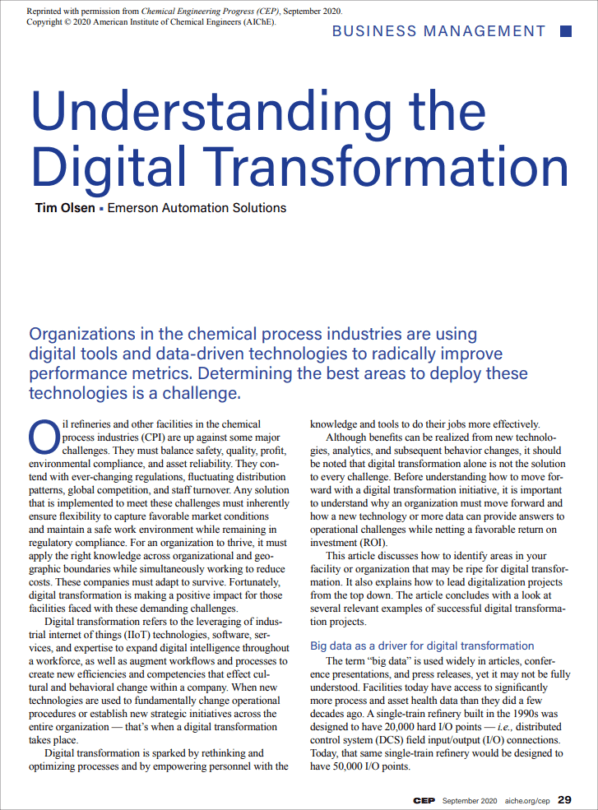 What often holds manufacturers and producers back on their digital transformation journeys is where to begin and how best to proceed. For those in the chemical process industries, Emerson’s Tim Olsen has written a Chemical Engineering Progress (CEP) article, Understanding the Digital Transformation.
What often holds manufacturers and producers back on their digital transformation journeys is where to begin and how best to proceed. For those in the chemical process industries, Emerson’s Tim Olsen has written a Chemical Engineering Progress (CEP) article, Understanding the Digital Transformation.
Tim opens with a great definition of digital transformation:
Digital transformation refers to the leveraging of industrial internet of things (IIoT) technologies, software, services, and expertise to expand digital intelligence throughout a workforce, as well as augment workflows and processes to create new efficiencies and competencies that affect culture and behavioral change within a company.
The key is to:
…fundamentally change operational procedures or establish new strategic initiatives across the entire organization…
Tim notes that the amount of information available to downstream producers has exploded.
A single-train refinery built in the 1990s was designed to have 20,000 hard I/O points—i.e., distributed control system (DCS) field input/output (I/O) connections. Today, that same single-train refinery would be designed to have 50,000 I/O points.
Developing a plan on how to better use this additional data to drive business performance improvements is a challenge.
Because no two operations are truly the same and every facility is at a different stage in its digital maturity, each facility will need a customized plan. Understanding where a facility currently is and where it needs to go is an important step in creating a digital transformation roadmap.
Tim explains that a digital transformation initiative starts with a clear vision and fit with the overall corporate strategy. He shares important steps in planning and implementing the strategy in a scalable approach:
- Perform a gap analysis
- Lead from the top down
- Identify missing data and required analytics
- Implement to project and train staff
- Confirm and document results
Read the article for more on each of these steps and examples of applications where digital transformations have occurred including catalyst performance monitoring, utility bottleneck identification and mitigation, emissions reporting automation, asset monitoring and analysis, and the use of advanced analytics and machine learning.
Visit the Downstream Hydrocarbons section on Emerson.com for more on the technologies, solutions and services to help drive your successful digital transformation strategy. You can also connect and interact with other digital transformation experts in the IIoT & Digital Transformation group in the Emerson Exchange 365 community.

